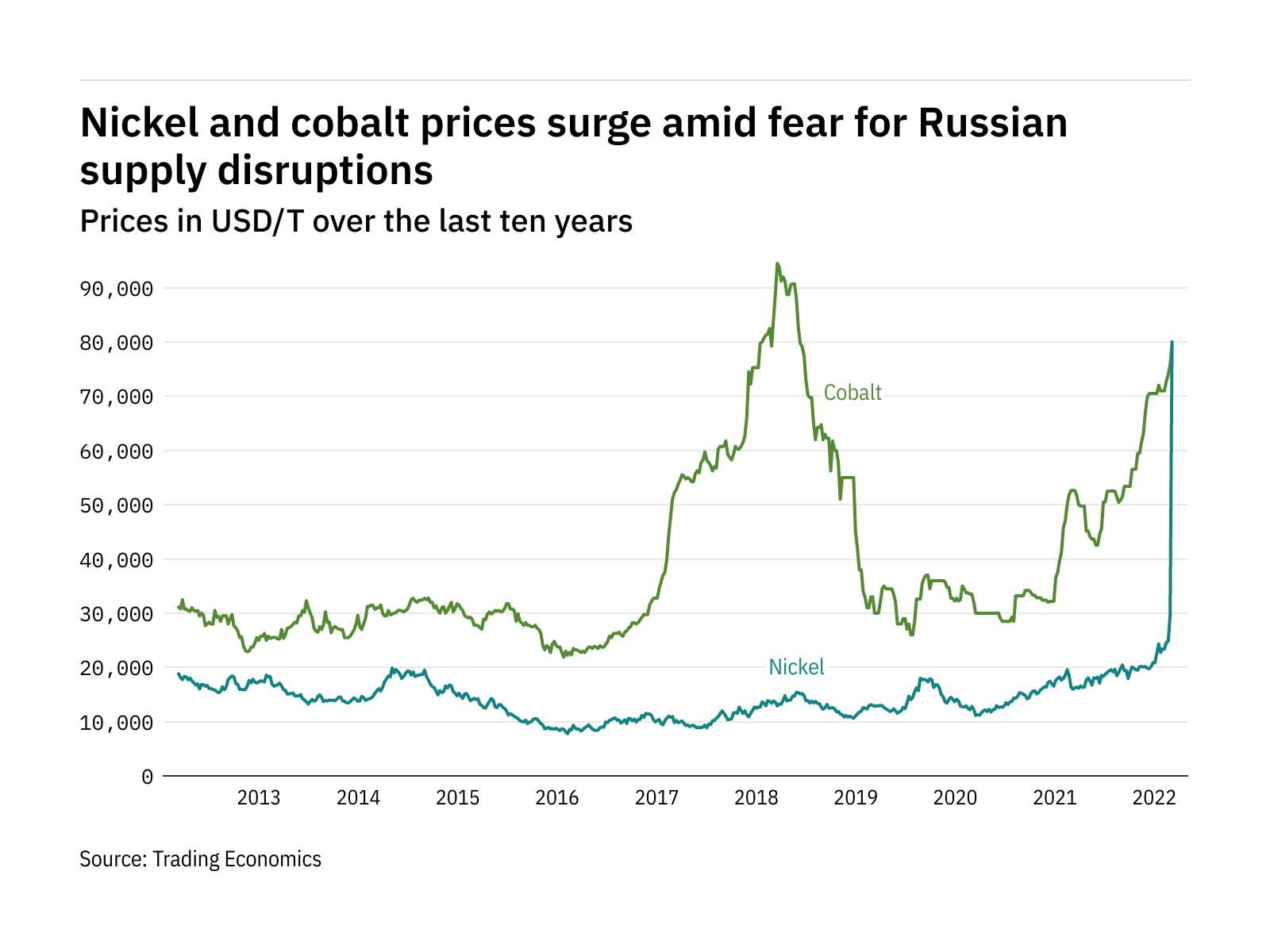
The price of cobalt stood at $79,295 per tonne on 7 March, its highest point since June 2018. On 8 March, nickel prices reached an unprecedented high of over $100,000 per tonne, resulting in the London Metal Exchange suspending trading in the commodity for the day.
Commodities and other markets have been seeing a surge in prices since the beginning of this week. Russia’s invasion of Ukraine resulted in sanctions targeting the Russian economy and disruptions to supply chains. Other than nickel and cobalt, the prices of palladium, gold, oil, and wheat also hit record highs.
Nickel and cobalt hold particular importance to the construction of batteries for electric vehicles (EVs). The most used battery type for EVs is the lithium-ion (Li-ion) battery, the key minerals for which are lithium, cobalt, nickel, graphite, and manganese.
In the last few years, EV sales have been booming. Sales in Europe hit a record increase in 2020, overtaking China as the region with the highest registrations. In 2019 and 2020, sales went up 142% compared to the year before.
While sales stagnated in 2021, 2.3 million registrations were still added to the EV stock last year. With total global electric car sales of 6.6 million, EVs sales made up almost 9% of the global car market. That number is expected to only rise as a result of many nations setting targets to phase out fossil fuel cars in the next decades.
With the demand for EVs rising, so does the demand for batteries and transition minerals. According to the IEA, the demand for EV batteries in Europe was 52.4 GWh/year in 2020. In 2019, that was still 24.9 GWh/year, an increase of 110%.
The growing demand for the minerals needed in the batteries poses a challenge for the mining sector. Minerals such as lithium, nickel, and cobalt are produced in just a handful of countries – more than half of the supply of each mineral comes from the top 3 producing countries. This makes the supply chain vulnerable to disruptions and price volatility.
Russia is the world’s second-largest cobalt producer, responsible for more than 6% of global cobalt production, as well as the third-largest nickel producer, with over 11% of global production.
It would be possible to get the supply of nickel and cobalt from countries other than Russia. Data from the United States Geological Survey (USGS) for example, shows that other than Russia, the Democratic Republic of the Congo (DRC) and Australia were the other top producers of cobalt, with 69% and 4% of total global production respectively. Indonesia and the Philippines are the other big producers of nickel, with more than 30% and 13% of production respectively.
However, there are limitations to the supply in the short term. Before the Russian invasion of Ukraine and rising tensions between the two countries, prices of transition minerals were already rising due to an increase in demand. The challenge for the mining industry is keeping up with this demand.
In May 2021, the International Energy Agency (IEA) released a report expressing their concerns about the future security of minerals essential for the energy transition, such as minerals for EVs.
“The data shows a looming mismatch between the world’s strengthened climate ambitions and the availability of critical minerals that are essential to realising those ambitions,” said Fatih Birol, executive director of the IEA, in a press release.
There is no lack of reserves for most of these minerals. According to USGS data, Indonesia, Australia, and Brazil have the biggest reserves in nickel, with an estimated global reserve of more than 95 million tons being identified. For cobalt, over 7.6 million tons of reserves have been identified, with the DRC, Australia, and Indonesia as the top three locations.
The difficulty lies in creating new mines to utilise those reserves. According to the IEA, moving a mining project from the discovery to the operational phase takes 16.5 years on average. The long development times “raise questions about the ability of supply to ramp up output if demand were to pick up rapidly”, according to the report. Or – as the case could be now – if there were a sudden disruption in the supply.
According to an analysis by GlobalData, Mining Technology’s parent company: “Two of the most important drivers for EV adaption has been the central subsidy and the battery prices."
The battery contributes around 35%-40% to the cost of an EV, according to the GlobalData report. If battery prices rise alongside commodity prices, it could impact the growth of EVs in the coming years, especially if the rise in prices is paired with an unclarity of subsidies, as is the case in Germany. As part of a stimulus package during the pandemic, the German Government introduced an innovation bonus of up to €9,000 for purely electrically powered vehicles until the end of 2022.
“Clarity on the subsidy level from 2023 onwards is currently unavailable,” writes analyst Mohit Prasad in the report. “With battery prices set to increase and clarity on the subsidy level from 2023 still not available, Germany might witness muted growth in EVs in the coming years.”



